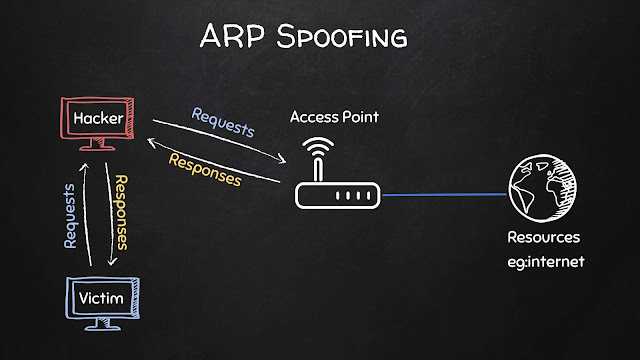ARPSPOOF: Network Tool
ARPSPOOF
What is arpspoof?

Arpspoof is a powerful network sniffing tool commonly used in network security testing and penetration testing. It operates by intercepting and manipulating Address Resolution Protocol (ARP) traffic on a local area network (LAN). ARP is a protocol used to map an IP address to a physical MAC address on a network. When devices communicate on a network, they use ARP to discover and associate IP addresses with MAC addresses.
Arpspoof works by sending forged ARP responses to a target or multiple targets on the same LAN. These ARP responses contain incorrect MAC address mappings, causing the affected devices to send their traffic to the attacker's machine instead of the intended destination. By capturing and analyzing this traffic, attackers can intercept sensitive information, such as login credentials, emails, or other data exchanged between devices on the network. One of the common applications of arpspoof is in man-in-the-middle (MITM) attacks, where an attacker intercepts and potentially alters the communication between two parties without their knowledge. For example, an attacker could use arpspoof to intercept the communication between a user and a router, allowing them to monitor or modify the data passing through.
It is important to note that arpspoof is typically used for ethical hacking and network security testing purposes by security professionals and penetration testers. However, it can also be misused by malicious individuals to perform unauthorized and harmful activities on a network, which is illegal and unethical. To defend against arpspoof attacks, network administrators can implement measures such as ARP spoofing detection tools, secure network configurations, and encryption protocols to protect sensitive data from interception and unauthorized access.
What are the features of this tool?
Arpspoof, a part of the Dsniff package, is a versatile tool with several features used primarily for network analysis and security testing. Some of its key features include:
- ARP Spoofing: Arpspoof's primary functionality is ARP spoofing, where it sends forged ARP responses to redirect traffic within a local network. By impersonating other devices, it can intercept and manipulate data packets.
- Man-in-the-Middle Attacks: Arpspoof is often used to conduct Man-in-the-Middle (MITM) attacks. By intercepting communication between two parties, it allows attackers to eavesdrop on the traffic, modify data, or inject malicious content.
- Session Hijacking: It can be used to hijack active network sessions. For example, if a user is logged into an online service, arpspoof can intercept the session cookies and allow an attacker to impersonate the user, gaining unauthorized access.
- Network Traffic Monitoring: Arpspoof can be employed for monitoring network traffic. Security professionals use it to analyze network behavior, identify vulnerabilities, and assess the effectiveness of security measures.
- DNS Spoofing: In addition to ARP spoofing, arpspoof can also be used in conjunction with other tools to perform DNS spoofing attacks. By redirecting DNS queries, attackers can lead users to malicious websites, phishing pages, or other fraudulent content.
- Debugging and Testing: Network administrators and developers often use arpspoof for debugging and testing purposes. By simulating network scenarios, they can identify potential issues in network configurations and applications.
- Educational Purposes: Arpspoof is used in educational settings to teach students about network security concepts, demonstrating how ARP spoofing attacks work and how to defend against them.
Steps to perform ARP Spoffing using arpspoof tool:-
Step1:- Enable IP Forwarding.
→ Before performing ARP spoofing, you need to enable IP forwarding on your Kali Linux using the command:"echo 1 > /proc/sys/net/ipv4/ip_forward".
→Then, run the following command to apply the changes:"sysctl -p".

→Use command "ifconfig" to find the network interface and system ip.

→Use command arp -n to find all available host ips.

Step3:- Perform ARP spoofing.
→To perform ARP spoofing use command "arpspoof -i <interface> -t <host_ip> <system_ip>"

Step4:- Saving captured traffic.
→Once the ARP spoofing is in effect, you can save the intercepted traffic in text file using the command:"tcpdump -i <interface> -l > captured_traffic.txt".

→Here we have the saved text file.



Comments
Post a Comment